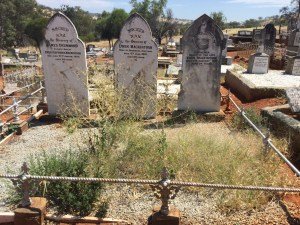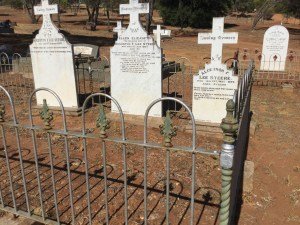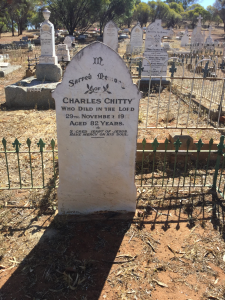When do the dead die? When they are forgotten –
Laura Esquivel, The Law of Love.
By Rebecca Doughty, Graduate Diploma Archaeology and Cultural Heritage Management student
Documenting the burial sites found in St Philip’s Anglican Cemetery, Culham, Toodyay, was like meeting with old friends. A quaint little cemetery, exclusive to original pioneers and their descendants, my past research came over me like a wave. The little gothic church stood by as I recorded, photographed and documented the sites in reverence.
Seventy four burials were identified between 1830-1930, many of which shared a similarity in materials and style.
Syred Family, St Philip’s Cemetery, Culham
As I carefully picked my way through I recognised the names and realised the marital connections of the people who had founded the Toodyay region, donated the land for the church and cemetery at Culham and first settled further along the Avon River, at Bejoording and Bolgart.

Drummond Family, St Philip’s Cemetery, Culham
My arrival at Toodyay Cemetery, however, was met with a greater sense of foreboding. This was the only cemetery which stood on the Main Street through town, where I was most obvious to curious eyes and it was also the largest cemetery of the four. The enormous space is divided into five sections: three were Roman Catholic which contained 71 sites and two were Anglican, which contained 157 sites. This cemetery took me two days to properly record. There were 228 burial sites in total and, again, an enormous number of familiar names from the district, such as Lee-Steere, Reverend Harper, Butterly and Chitty. Their descendants are still living here today.

Lee Steere Family, Toodyay Cemetery, Toodyay
As I had anticipated, my recording brought the attention of local residents and before long I was hosting an impromptu information session for a small group of elderly people, explaining my purpose, intentions and methods. Once they realised I was not there to desecrate the final resting places of their great grandmothers, aunts, relatives and friends, I was left to complete my work.
I returned home with my precious photographs, careful measurements and descriptions and set about analysing the results.

Chitty Family, Toodyay Cemetery, Toodyay
As I set up tables and documented total burials I felt privileged to be trusted by the Toodyay Cultural Heritage Officer, with such private and precious information; I held the history of the township in my hands and was determined to do it justice in my report.

Butterly Family, Toodyay Cemetery, Toodyay
And so the analysis begins and a careful study of those prominent names of the district. Just how were these people remembered in death and did the burial practices employed reflect the social and economic position they had enjoyed in life? We shall see.

